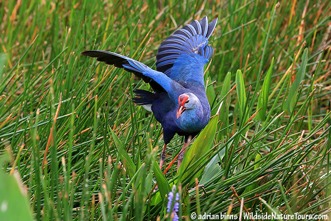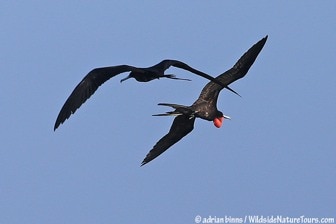TRIP REPORT: DRY TORTUGAS & SOUTH FLORIDA – 2015 April

TOUR FOCUS
TRIP LEADERS
PRIVATE TOUR OPTION
This tour is available as a private trip for any size group. The tour cost will vary with the number of people and any custom requests.
TESTIMONIALS
Trip report by Adrian Binns
Day 1 / April 21 – Miami; West Palm Beach; Wakodahatchee; Green Cay NC
Our South Florida tour began with overcast skies and oppressive humidity as we watched dozens of White-winged Parakeets at dawn leave their nest holes in Canary Island Palms and chatter away on the fronds before heading off to feed.

Spot-breasted Oriole
We managed to get in a couple more exotics, Spot-breasted Oriole and Red-whiskered Bulbul before the ominous clouds opened up and deluged this sub- tropical part of Florida. The oriole was calling shortly after we got out the van, and a pair put on a wonderful close show just as a landscaping crew showed up to mow. It wasn’t one house they were servicing but it seemed like half the neighbourhood. With the noise pretty unbearable we spread ourselves out over a couple of streets, and Glenn soon spotted bulbuls on the wires away from the racket.
By the time we reached the Burrowing Owls in Broward County, an hour to the north of Miami, the storms had moved through and we never saw another drop. The owls cooperated nicely showing off as they guarded their burrows.
Another exotic, the Nanday Parakeet was quickly located with the help of my good friend James Currie. In fact there would be five of them including a pair at a nesting site that we found. While looking at the first Nanday we also got another look at Spot-breasted Oriole. We were off to an excellent start!
 After picking up lunch at Publix we spent the remainder of the afternoon walking the boardwalks at the two wonderful wetlands, Wakodahatchee and Green Cay, both part of the West Palm Beach water treatment program.
After picking up lunch at Publix we spent the remainder of the afternoon walking the boardwalks at the two wonderful wetlands, Wakodahatchee and Green Cay, both part of the West Palm Beach water treatment program.
Highlights included many chicks of various sizes including Anhinga and Wood Stork on their nest, Green Herons out of the nest and two or three day old Common Gallinule and Mottled Duck chicks following and begging their parents for food; a Little Blue and Tri-colored Heron, both in top breeding plumage squabbling over a nesting site; wonderful comparison of Purple Gallinule and Purple Swamphen, the latter also seen on a nest; hearing a big splash (alligator) followed by all kinds of commotion from Common Gallinules and American Coots, these two being very upset no doubt that they had just lost a friend; catching a bit of warbler migration coming across Blackpoll,
Northern Parula, Black-and-white, Black-throated Blue, Common Yellowthroat, Ovenbird, American Redstart, Cape May and Prairie Warbler; a wide assortment of dragonflies, Halloween Pennant, Eastern Pondhawk, Four-spotted Pennant, Golden-winged Skimmer, Roseate Skimmer, Scarlet Skimmer, Blue Dasher, Pin-tailed Pondhawk, Great Pondhawk and Eastern Amberwing; Marsh Rabbit, numerous Brown Anoles and a Southeastern Five-lined Skinks as well as Zebra Longwings, White Peacock, Monarch and Gulf Fritillary; multiple Least Bittern sightings culminating in watching a female catch a bullfrog tadpole and watching a pair of Limpkins rounded out an excellent start to the trip.
Day 2/ April 22 – Dupuis WMA; Lake Marian; Joe Overstreet/Lake Kissimmee; Avon Park
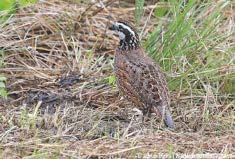
Northern Bobwhite
On this overcast morning with a few showers passing through Dupuis Wildlife Management Area we came across a confiding pair of Northern Bobwhite and a Swallow-tailed Kite sitting on a snag. Walking through recently burnt pinelands, we soon came across Carolina Wren, Great Crested Flycatcher as well an Oak Toad but there was no sign of a Red-cockaded Woodpecker in spite of several nest holes with sap oozing from the around them. We tried another section and quickly found two Red-cockaded in the rain, which along with a singing Bachman’s Sparrow showed well. Thrilled with our sightings we continued along Lake Okeechobee keeping an eye our for any Snail Kites before heading north through the prairies and farmland. Along this stretch we would encounter our first Sandhill Cranes and Crested Caracara. By late morning sunny blue skies and low humidity made for a very pleasant remainder of the day.
Once we reached the southern end of the ‘lakes region’ of central Florida we stopped in at Lake Marion. Bev found three Florida Banded Snake amongst the waterlilies below the gazebo overlook. American White Pelicans were conspicuously relaxed as they floated by us and the usual assortment of wading birds were amongst the rushes along the edges but no Snail Kite. Eastern Meadowlarks, Loggerhead Shrikes and a single Wild Turkey were along Joe Overstreet. At the end of the road we scoured Lake Kissimmee for Snail Kites before eventually finding a pair quartering around a distant row of shrubs. With scope views we were clearly able to pick out their features and watch one carrying an apple snail.

Egyptian Geese
Heading west towards Avon Park an accident along the road meant that we had to turn around and make an eighty mile detour to get to where we wanted be, which was to look for Short-tailed Hawk. As luck would have it along the way a dark morph Short-tailed was spotted close to the road. As that bird was flying away from us Doug found a distant light morph in his scope that was carrying a small bird in its talons. Better views were certainly in order for this species! Another roadside stop was for five Swallow-tailed Kites hunting over the tops of pines. Upon entering Avon Park Jak spotted Egyptian Geese on the edge of a small pond so yet another countable exotic was added to the list.
Day 3 / April 23 – Lake Weohyakapka; Archbold Biological Station; 216th Street; Cutler Wetland
We returned to the Lake Weohyakapka area to see if we could get a better sighting of Short-tailed Hawk but the overcast start to the day and drizzle meant that neither the hawk or the ubiquitous vultures were taking to the air. However we did have a wonderful experience watching a Barred Owl calling hooting and swooping down to pick up prey off the ground. A calling Tufted Titmouse was the only other new bird in this region for the trip.

Florida Scrub-Jay
At Archbold Biological Station amongst the scrub oaks, Florida Scrub Jays continue to put on a close show for us making it easy to separate this endemic species by its markings from its cousins in the western part of the country. In the open prairie areas and adjacent pinelands we encountered Eastern Bluebirds, a gorgeous pair of Red-headed Woodpeckers and the ‘white-eyed’ Florida race of Eastern Towhee, with its eye looking more yellow than is described.
Leaving the south central region we made the long journey to south of Miami going through intermitted rain showers. Just as we reach the 216th Street bridge a strong rainstorm was passing over us, but being sheltered under the bride we were able to hang out and watch the Caribbean race of Cave Swallow flying into its nest.
We certainly had far better looks at them a short while later, after the storm passed, at Cutler Wetlands when a flock of ten circled over the shallow pond. A nice sight at this location was a group of five colorful breeding plumaged Long-billed Dowitchers.
We began our search for the elusive Mangrove Cuckoo along the mangrove lined coast of south east Florida, but as is often the case, patience and time is needed to come across one. There would be more chances! The day ended with a multitude of Muscovy Ducks at a Homestead pond happily being fed by a local resident!
Day 4 / April 24 – Dagny Johnson Key Largo State Botanical Park; Crocodile NWR; Cardsound Bridge; Everglades National Park
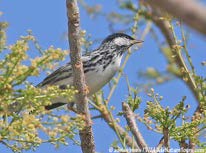
Black-and-white Warbler
It was a quiet morning as we left before daybreak with the exception of a Cuban Treefrog! With Mangrove Cuckoo being our target, our first stop was on Upper Key Largo at Dagny Johnson Key Largo State Botanical Garden. Migration was slow, coming across only a couple of individual Blackpoll, Cape May, Black-and-white and Black-throated Blue. Glenn found a nighthawk perched on an open branch that was probably best left as uncertain as to which species it was, Common or Antillean. There was plenty of White-eyed Vireos singing away and a bird that sounded like a Thick-billed Vireo but without it showing itself and knowing all the variations that White-eyed can sing, it is best left as unknown. After an hour I heard a Mangrove Cuckoo call once and Jak and Bev soon located it. It never ceases to amaze me how stealth that bird is, magically appearing out of thin air, but this time never sitting in one place for more than a minute, and often just in a location that only had a small opening to view it. At least everyone was able to get on the bird was satisfactory looks. Surprisingly there was no Black-whiskered Vireo.
Mission accomplished we headed to Everglades National Park via Crocodile National Wildlife Refugee where a flotilla of American White Pelican and our first Roseate Spoonbill was a pleasant sight. Along Cardsound Bridge road we picked up Cuban Golden Yellow Warbler in a mangrove with a Prairie Warbler beside it.
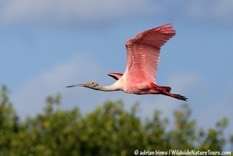
Roseate Spoonbill
The afternoon was spent in the Everglades taking the 38 mile drive all the way to Flamingo. After visiting the wonderful Visitor’s Center our first stop was Paurotis Pond where a multitude of waders nest. The most conspicuous being Roseate Spoonbills and Wood Storks. At Nile Mile Pond a number of Forster’s Terns were flying around the pond, and, one could walk up to Osprey, Black and Turkey Vultures. Mrazak Pond was very shallow and ringed with mudflats. A few Black-necked Stilts enjoying the tanin coloured water. Jak spotted a couple of Solitary Sandpiper along the edge, one of which flew close to us to the delight of the photographers.
Having reached Flamingo we spend most of our time time playing chase the cowbird flock! Amongst the couple dozen Brown-headed were two male Shiny Cowbirds. Red-shouldered Hawk, Swallow-tailed Kite, Pileated Woodpecker, Baltimore Oriole and Summer Tanager were encountered during that particular walk!

Being low tide the sand spit off the marina held four tern species, Least, Gull-billed, Royal and Caspian, along with Brown Pelican, Short-billed Dowitcher and Dunlin. A Reddish Egret was dancing just behind the spit and in the distance we could pick out a Great White Heron and a Wurdemann’s Heron. Along the shoreline by the campground we added a few Least Tern and got a close look at a Gull-billed Tern standing besides a Laughing Gull. Good for bill comparison! Glenn dropped his glasses in the grasses walking from the van to the shoreline, so we scoured the area, and on the second go round Jak, of course, found them! The American Crocodile in the marina only showed itself briefly before submerging!
Following an excellent mexican meal at El Toro Taco we watched a Common Nighthawk calling in the fading light.
Day 5 / April 25 – The Keys – Marathon; Ohio Key; Key West Botanical Garden; Indigenous Park; Zachary Taylor SP
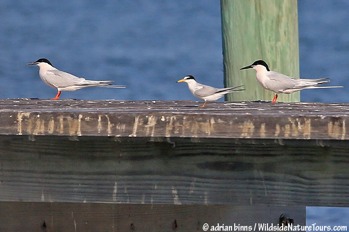
Roseate Terns with Least Tern
It was an early start for the drive down the Keys. The 120 mile journey went smoothly but with record heat and humid it was oppressive! Almost half way down we visited Edna Key where a Reddish Egret was dancing, a Belted Kingfisher was surveying the still water, and a Red-breasted Merganser was sitting on a small limestone outcropping. On Marathon, a boat dock had a pair of Roseate Terns side by side with Least Terns for a nice comparison of size, structure and colour. For Shirley, the Roseate’s were her 600th ABA bird. The shallow pond on Ohio Key held a small flock of roosting Semipalmated Sandpiper, with one Western amongst them, as well as a few Semipalmated Plovers. In the water both morphs of Reddish Egrets were actively feeding.

Bahama Mockingbird
Surprisingly the warblers were rather light once we reached Key West. Between the three parks that we visited, the Botanical Gardens, Indigenous and Zachary Taylor, there was only Palm, Blackpoll, Common Yellowthroat, Yellow, Northern Waterthrush and Ovenbird. However, there was a nice splattering of other passerines including both Summer and Scarlet Tanager, Rose-breasted Grosbeak, Yellow-billed Cuckoo, Acadian Flycatcher, Red-eyed and Black-whiskered Vireo, Swainson’s and Gray-cheeked Thrush, Painted Bunting and many Indigo Buntings, but the highlight was certainly a very co-operative Bahama Mockingbird feeding in a Gumbo Limbo at the Botanical Garden.
After a quick early dinner we were joined by Joel, Donna, Tim and Pavana at the marina on Stock Island to board our boat the “Playmate,” for our three day journey to the Dry Tortugas.
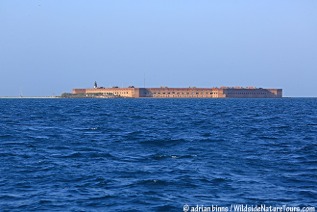
Day 6 / April 26 – The Dry Tortugas: Gulf Stream to Fort Jefferson
At about 4.30am we heard the rumbling of the engines. While Captain Joe had us departing Key West for the Dry Tortugas, we were able to get few more hours of sleep before Jen had breakfast prepared. for us.
The seas were relatively calm with 10 knot winds and a few white caps. In the Gulf Stream we worked depths of between 150 and 650 feet and soon began to see our first Audubon’s Shearwaters. Twenty birds later we encountered several sitting on the water and making short flights. While we saw a dozen Bridled Terns feeding along weed lines it was a pair sitting on a piece bamboo that gave us our best looks, including easily being able to see the white behind the eye. Joining us for part of the way was a female Magnificent Frigatebird that sat on the bow of the boat.
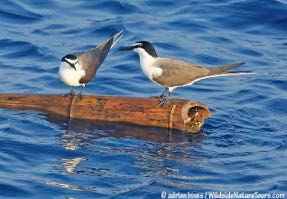
Bridled Terns
At Tail’s End, the marker held three Brown Boobies of various ages, with all clearly showing a demarcation on the breast. Amongst the sea creatures an Atlantic Bottled-nosed Dolphin swam along the bow, a Green Turtle showed briefly before submerging and there were several Flying Fish.
By mid day we had reach the Dry Tortugas park boundary and passed the first of the seven coral islands that make up the Dry Tortugas. At Hospital Key we got as close to the Masked Bobby colony as we could. About 50 birds were spread out along the narrow island mainly in groups at either end. A few birds took to the air with one flying out to sea away from us.
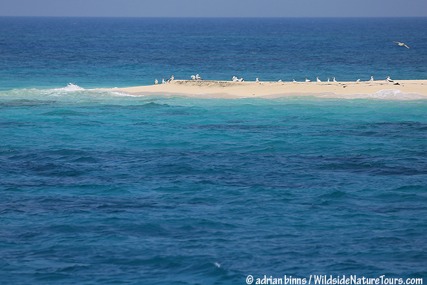
We docked on Garden Key, 70 miles west of Key West, which is home to the 18th century Fort Jefferson. Nearly thirty years (1846-75) in the making, the fort, the largest brick structure in the Americas, was built to protect the important shipping routes in the Gulf of Mexico. During the Civil War it was used as a Union prison for deserters, and by the 1880‘s abandoned having never been completed.

Chuck-wills-widow
Exploring all the shrubs, trees and leaf litter below them we found a wonderful variety of migrants though the numbers of individuals was low. Three thrush species were walking around the water fountain and campground, Wood, Gray-cheeked and a Veery. Much to everyone’s delight there was not one but two Chuck-wills-widows perched low in the buttonwoods by the campground beach. At twice the bulk of nighthawks they are certainly very impressive.
14 species of warblers would be tallied including Hooded, Kentucky, Worm-eating, Magnolia, Bay-breasted, Prairie, Palm, Blackpoll, Northern Parula, Black-and-white, Cape May, American Redstart, Ovenbird and a first year male Townsend Warbler that was found by a visiting western birder, very familiar with it!
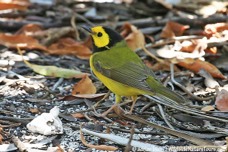
Hooded Warbler
A cooperative Black-whiskered Vireo meant that those that did not get to see the whiskers on the one at Zachary Taylor certainly did today. The brilliant Rose-breasted Grosbeak, Summer and Scarlet Tanagers lit up the trees, while the duller by comparison Eastern Wood Pewee was often heard calling. A Ruby-throated Hummingbird visited the flowering geiger tree. Circling around the fort in an effort to find insects were Cave, Cliff, Northern Rough-winged and Barn Swallows, and the ever present raptors were represented by Peregrine, American Kestrel and several Merlins all waiting for a passing passerine.

The seabird colony on Bush Key was full of life and noise with over 80,000 Sooty Terns and 5,000 Brown Noddies flying all over. During the course of our stay we would spend many hours scanning the terns and noddy colony on Bush Key for the Black Noddy. As Jak said, “it was like looking for malaria amongst red blood cells, except that the red blood cells don’t move!” It wasn’t until we all got back on the boat before dinner that Captain Joe asked me to check out a bird in a sea lavender that he thought had potential. Lo and behold in the bush that I had been checking from the top of the fort, there was a Black Noddy in the shade, its perfect solid white cap very obvious. For Jak this would be cause for celebration as it marked his 1000th life bird.
Day 7 / April 27 – The Dry Tortugas
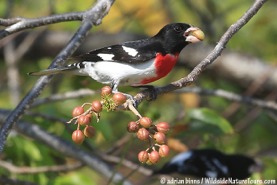
Rose-breasted Grosbeak
It was back onto Garden Key after daybreak. We spent a great deal of time within the parade grounds inside Fort Jefferson working our way along the western side between the Gumbo Limbos and Sea Grapes. With the winds continuing to be light out of the south many of the same birds as yesterday were around.
The three thrush species, Veery, Gray-cheeked and Wood, Rose-breasted Grosbeak, the vireos, Black-whiskered and Red-eyed and two tanager species, Summer and Scarlet. One Merlin was still there to harass some of the warblers that remained. It was nice to see that most of the swallows had left with only a few Barn and a Cliff remaining. They often suffer from lack of flying insects and consequently exhaustion in their endless forays to find a meal. New arrivals included two male Dickcissels, a female Shiny Cowbird, Blue Grosbeak, Yellow-billed Cuckoo, Yellow-crowned Night-Heron and a Spotted Sandpiper that was doing a marvelous job balancing itself as it walked along the vertical brick wall above the moat!
Before the last of the group had returned to the “Playmate” for lunch I had located the Black Noddy on the Bush Key. It was not far from where we saw it late yesterday but at least this time we were on solid ground and not a rocking and rising boat! After lunch everyone in the group got to see the bird, a good thing as later in the afternoon it was not to be found!

Brown Noddies
Half the group opted to rest up in the stifling heat and humidity, as bad as I ever recall it. Dale, Bev, Doug and I joined Tim and Jak at the fountain, where we spent an hour and half in the early to mid afternoon hoping something would show up. The activity was incredibly slow, the heat no doubt having much to do with that. After an hour and half Dale, Bev, Doug and I decided to get a closer look at the tern colony by walking as far as the Island Closed sign and then getting close to the Brown Noddies sitting on the North Coaling Docks.
Tim and Jak decided to wait at the fountain, where beginning about ten minutes after we left, there would be thirty minutes of a steady parade of birds coming to drink beginning with a female Shiny Cowbird and a pair of Dickcissels, followed by a young male Painted Bunting, female Scarlet Tanager, Palm Warblers, Rose-breasted Grosbeak, Blackpoll, Indigo Buntings, Bay-breasted Warbler, Townsend Warbler, Yellow-throated Warbler, Black-whiskered and Red-eyed Vireo!
 Adam took us in the tender, in groups of 4, to the Magnificent Frigatebird colony on Long Key. The short journey on calm waters late in the afternoon was most relaxing. Sooty Terns and Brown Noddies flew away from Bush Key and passed by us dropping down to skim the water for a drink and continuing on a short distance before stalling as they shook the salt out. Between the three tender trips that it would take for the whole group to see the frigatebirds, we also saw Belted Kingfisher, Yellow-crowned Night Heron, Great White Heron, four Peregrines and three Brown Pelican flying in unison and diving from great heights into the shallow water.
Adam took us in the tender, in groups of 4, to the Magnificent Frigatebird colony on Long Key. The short journey on calm waters late in the afternoon was most relaxing. Sooty Terns and Brown Noddies flew away from Bush Key and passed by us dropping down to skim the water for a drink and continuing on a short distance before stalling as they shook the salt out. Between the three tender trips that it would take for the whole group to see the frigatebirds, we also saw Belted Kingfisher, Yellow-crowned Night Heron, Great White Heron, four Peregrines and three Brown Pelican flying in unison and diving from great heights into the shallow water.
Day 8 / April 28 – The Dry Tortugas to Key West; The Keys
With continuing southerly winds, though now stronger than the previous two days, I expected that some of the birds in the fort would have flown overnight. Being our last chance to see what was around, we docked at Garden Key at 7am and split up to check what was around for an hour. Bev and Dale located Black-bellied Plovers on the south coaling dock pilings and the Kentucky Warbler in the campground while the sea grapes and gumbo limbo trees within the parade grounds had a few birds including Bay-breasted and Magnolia. Overall the numbers were fewer than yesterday.

We departed the Dry Tortugas at 8am for the 7 hour journey back to Key West. We were warned that the conditions at sea would be rougher than our trip out. With 4-8 foot swells, we battened down the hatches and toughed out the ride. We slowed down at the O marker within the park and found a Brown Booby, a Roseate Tern and two Bridled Terns. As we approached Stock Island the #8 and #9 channel markers held almost two dozen Roseate Terns and a few Sandwich Terns. By mid afternoon we said goodbye to the outstanding crew, Captain Joe, Adam and Jenny, and began our journey back up the Keys.
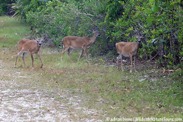 In the late afternoon we drove through Big Pine Key observing the diminutive Key West Deer in residential yards and along No Name Deer. Of note was a buck that had lost one side of his rack leaving him as a three-pointer!
In the late afternoon we drove through Big Pine Key observing the diminutive Key West Deer in residential yards and along No Name Deer. Of note was a buck that had lost one side of his rack leaving him as a three-pointer!
We timed dinner perfectly at the Seven Mile Grille in Marathon as a storm rolled through the Keys. We followed dinner watching a lovely sunset at the airport as a dozen White-crowned Pigeons came to roost. Minutes later we heard an Antillean Nighthawk calling from across the runway and watched as it came towards us, circled over our heads and proceeding to display in its characteristic dive from a great height to just above ground level before rising again and circling around us. Given what the weather conditions were like an hour earlier we could not have asked for a more fitting ending to a wonderful four days in the Keys.
Day 9 / April 29 – Everglades; Matheson Hammock
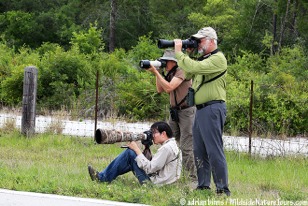 A tropical storm out of the north and west descended upon South Florida overnight and continued throughout the morning dumping 5 inches over the region and curtailing our planned activities. In spite of the deluge we forged ahead, going into the Everglades in the hopes we would get a break. The Cape Sable Seaside Sparrow was our first target, which we did hear amongst the sawgrass but it never popped up in the rain. Unfortunately the conditions would make it too tough to locate Brown-headed Nuthatch and Pine Warbler.
A tropical storm out of the north and west descended upon South Florida overnight and continued throughout the morning dumping 5 inches over the region and curtailing our planned activities. In spite of the deluge we forged ahead, going into the Everglades in the hopes we would get a break. The Cape Sable Seaside Sparrow was our first target, which we did hear amongst the sawgrass but it never popped up in the rain. Unfortunately the conditions would make it too tough to locate Brown-headed Nuthatch and Pine Warbler.
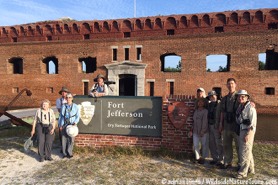 Following a break at Starbucks we dropped Glenn off to pick up his rental car (he was continuing north on his personnel quest for a Big Year) and the rest of us made our way to Matheson Hammock Park for a last look for any exotic species. The Hill Mynas were not around, but in a light rain we ended the trip with a flock of five Orange-winged Parrots and a pair of Mitred Parakeets.
Following a break at Starbucks we dropped Glenn off to pick up his rental car (he was continuing north on his personnel quest for a Big Year) and the rest of us made our way to Matheson Hammock Park for a last look for any exotic species. The Hill Mynas were not around, but in a light rain we ended the trip with a flock of five Orange-winged Parrots and a pair of Mitred Parakeets.
This was a outstanding trip with many targets falling in place making each day run smoothly. We covered many different parts and habitats of the southern state, seeing 182 species (plus 2 subspecies, 3 morphs and 2 exotics) including Swallow-tailed Kites, Antillean Nighthawk, Mangrove Cuckoo, Bahama Mockingbird, 20 species of warblers on the Dry Tortugas as well Black Noddy and Chuck’s-will-widow.
